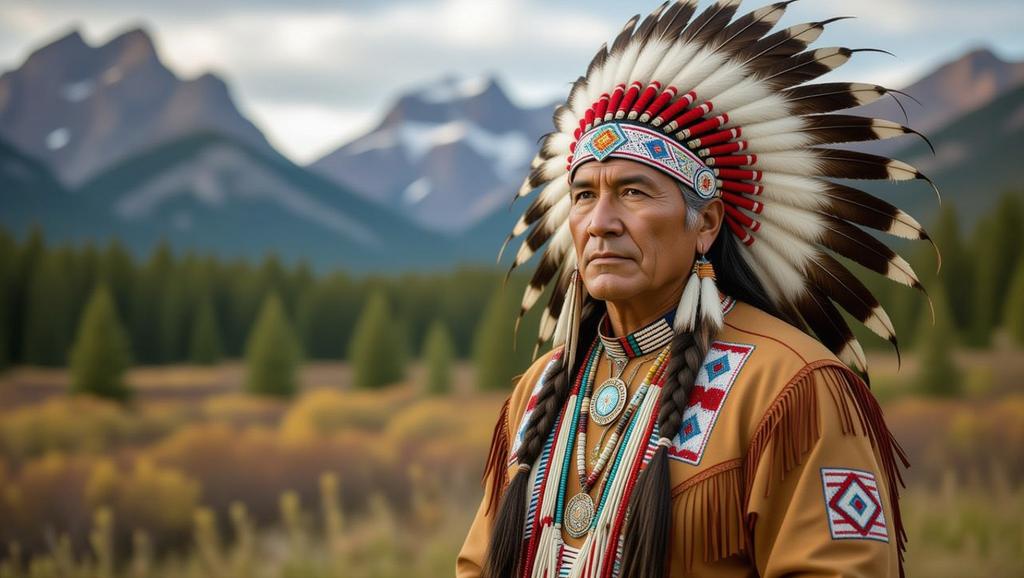The Historical Context of Native American Clothing
When we think about fashion, it’s easy to get caught up in the latest trends from Paris or Milan. But let me tell you, the fashion history of Native Americans is just as rich and diverse, if not more so. It’s a journey that takes us back centuries before the arrival of Europeans on this continent, and it’s a story I’m excited to share with you here on tinitees.com.
The clothing of Native Americans wasn’t just about keeping warm or looking good; it was deeply intertwined with their culture, environment, and way of life. Each tribe had its own unique style, influenced by the materials available to them and the climate they lived in. It’s fascinating to see how these elements shaped their attire, and I think it’s a testament to the ingenuity and creativity of these peoples.
I remember the first time I learned about the detailed craftsmanship behind Native American clothing. It was like stepping into a whole new world of fashion. The way they used natural materials and turned them into works of art is something that still blows my mind. And the best part? This isn’t just history; it’s a living tradition that continues to influence fashion today.

Traditional Materials and Techniques
One of the things that always stood out to me about Native American clothing is the materials they used. It’s all about working with what nature provides, and boy, did they make the most of it! Cotton, for example, was a big deal in the Southwest. It’s light, breathable, and perfect for those hot desert days. But not everyone had access to cotton, so tribes in other regions got creative with what they had.
Take the Southeast, where they used mulberry bark to create soft fibers for weaving. Or the Northwest, where redwood was the go-to material. And let’s not forget the Plains, where sagebrush was turned into everything from leggings to dresses. It’s amazing how resourceful these communities were, and it’s a reminder that fashion can be sustainable and beautiful at the same time.
When it comes to techniques, the use of animal skins was widespread, especially in the Plains where plant fibers were scarce. They would work these skins into a soft, suede-like material that was both durable and warm. And the way they sewed it all together? With animal sinew and porcupine quill-needles! It’s craftsmanship at its finest, and it’s something I wish more modern fashion could emulate.
Influence of Environment and Resources
The environment played a huge role in shaping Native American fashion. In warmer climates, you’d see men wearing minimal clothing, like breechclouts and moccasins, while women might wear skirts or full-length dresses. But when winter rolled around, it was all about bundling up in long-sleeve shirts, coats, and robes.
It’s interesting to think about how the nomadic lifestyle of many Native American societies influenced their clothing choices. Most people only owned one set of clothes, which had to be versatile enough to handle different seasons and activities. It’s a far cry from the endless wardrobe options we have today, but it’s a reminder of how adaptable and practical their fashion was.
The resources available in each region also played a big part in the styles that emerged. For example, the abundance of feathers in some areas led to their use in ceremonial headdresses, which were highly valued and often reserved for rulers or important figures. It’s a fascinating example of how the environment can shape not just the materials used, but also the symbolism and significance of clothing.
Cultural Significance of Native American Attire
Now, let’s dive into the cultural significance of Native American clothing. It’s not just about what they wear, but why they wear it. And trust me, there’s a lot more to it than meets the eye.
Clothing in Native American cultures was a powerful tool for communication. It told a story about the wearer’s tribe, family, and personal identity. Each piece of clothing was like a canvas, decorated with symbols and designs that carried deep meaning. It’s a bit like how we use fashion today to express ourselves, but on a much more profound level.
One thing that always struck me is how clothing was used to honor and connect with ancestors. It’s not just about looking good; it’s about carrying forward a legacy and keeping traditions alive. And that’s something I think we can all learn from, no matter where we come from.
Symbolism in Clothing
The symbolism in Native American clothing is truly fascinating. Every pattern, color, and design had a story to tell. For example, the use of feathers in headdresses was often a sign of status and spiritual significance. It’s like wearing a piece of your history and culture right on your head!
And let’s not forget about the intricate beadwork and quillwork that adorned many garments. These weren’t just decorative elements; they were a way to communicate tribal affiliation, family ties, and personal achievements. It’s a bit like how we might wear a family heirloom or a piece of jewelry that has special meaning to us.
I remember seeing a beaded dress from the Sioux tribe at a museum once. The detail was incredible, and you could tell that each bead was placed with intention and care. It’s a reminder that fashion can be a form of storytelling, and it’s something that I think we should all appreciate more.
Ceremonial and Everyday Wear
In Native American cultures, there was a clear distinction between ceremonial and everyday wear. Ceremonial clothing was reserved for special occasions like religious rituals, dances, and warfare. These garments were often the most elaborately decorated, with symbols and designs that carried deep spiritual meaning.
On the other hand, everyday wear was more practical and functional. It had to be comfortable and durable enough to handle the rigors of daily life, whether that meant hunting, gathering, or traveling. But even in these everyday garments, you could see the influence of culture and tradition. It’s a reminder that fashion can be both beautiful and practical at the same time.
One of my favorite examples of ceremonial wear is the headdress. These weren’t just fashion statements; they were symbols of power, status, and spiritual connection. And the materials used, like feathers, were often highly valued and reserved for important figures. It’s a fascinating example of how clothing can be more than just fabric; it can be a reflection of a person’s place in the world.
Evolution of Native American Fashion
The evolution of Native American fashion is a story of resilience and adaptation. From the arrival of European settlers to the modern-day revival of traditional styles, it’s a journey that’s as complex as it is beautiful.
Before European contact, Native American clothing was all about working with what nature provided. But with the arrival of traders and settlers, new materials and techniques started to influence their fashion. Glass seed beads, for example, became a popular material for decoration, replacing traditional quillwork in many areas.
But it’s not just about the materials; it’s also about how Native Americans have continued to adapt and evolve their fashion over time. From the reservation period, where beaded dresses became a symbol of status and celebration, to the modern-day powwows where traditional regalia is still worn with pride, it’s a testament to the enduring legacy of Native American fashion.
Impact of European Colonization
The arrival of Europeans had a profound impact on Native American fashion. With them came new materials like cloth, blankets, and German silver, which were quickly integrated into traditional garments. It’s a fascinating example of how cultures can influence each other, even in the face of adversity.
But it wasn’t just about the materials; it was also about the exchange of ideas and techniques. For example, the introduction of glass seed beads led to a shift from quillwork to beadwork in many areas. It’s a reminder that fashion is always evolving, and it’s a testament to the adaptability and creativity of Native American communities.
One of the things that always struck me about this period is how Native Americans were able to take these new materials and make them their own. They didn’t just adopt European styles; they integrated them into their own traditions, creating something entirely new and unique. It’s a powerful example of cultural resilience and creativity.
Modern Adaptations and Revivals
Today, Native American fashion is experiencing a revival, thanks in part to the work of contemporary designers who are bringing traditional styles and techniques to the modern runway. It’s a beautiful blend of old and new, and it’s something that I think we can all appreciate.
From beaded dresses to intricately designed moccasins, these modern adaptations are a testament to the enduring legacy of Native American fashion. They’re not just about looking good; they’re about carrying forward a rich cultural heritage and keeping traditions alive.
One of my favorite examples of this revival is the work of designers like
Read more Why do these 5 office looks always get compliments?
who are using traditional techniques like beadwork and quillwork to create stunning contemporary pieces. It’s a reminder that fashion can be a powerful tool for cultural preservation and expression.
Regional Variations in Native American Dress
One of the things that makes Native American fashion so fascinating is the regional variations in dress. Each tribe had its own unique style, influenced by the materials available to them and the climate they lived in. It’s a bit like how we have different fashion trends in different parts of the world today.
From the Plains tribes, with their iconic feathered headdresses and fringed garments, to the Southwestern nations, with their vibrant use of cotton and intricate beadwork, to the Northeastern Woodlands, with their use of animal skins and natural dyes, each region had its own distinct style. It’s a testament to the diversity and creativity of Native American communities.
Clothing Styles of the Plains Tribes
The Plains tribes are perhaps best known for their iconic feathered headdresses and fringed garments. These weren’t just fashion statements; they were symbols of power, status, and spiritual connection. And the materials used, like feathers and animal skins, were often highly valued and reserved for important figures.
But it’s not just about the headdresses; it’s also about the everyday wear of the Plains tribes. From the soft, suede-like material of their garments to the intricate beadwork and quillwork that adorned them, these were people who knew how to make the most of what nature provided. It’s a reminder that fashion can be both practical and beautiful at the same time.
One of my favorite examples of Plains fashion is the beaded suit from the Sioux tribe. The detail is incredible, and you can see the influence of both traditional and European materials in its design. It’s a powerful example of how cultures can influence each other, even in the face of adversity.
Attire of the Southwestern Nations
The Southwestern nations had a unique style all their own, thanks in part to the abundance of cotton in the region. This lightweight, breathable material was perfect for the hot desert climate, and it was used to create everything from socks to skirts to leggings.
But it’s not just about the cotton; it’s also about the intricate beadwork and other decorations that adorned Southwestern garments. These weren’t just decorative elements; they were a way to communicate tribal affiliation, family ties, and personal achievements. It’s a bit like how we might wear a family heirloom or a piece of jewelry that has special meaning to us.
One of my favorite examples of Southwestern fashion is the beaded dress from the Sioux tribe. The detail is incredible, and you can see the influence of both traditional and European materials in its design. It’s a reminder that fashion can be a form of storytelling, and it’s something that I think we should all appreciate more.
Garments of the Northeastern Woodlands
The Northeastern Woodlands tribes had their own unique style, thanks in part to the abundance of animal skins and natural dyes in the region. These were used to create everything from leggings to dresses to jackets, and the craftsmanship was truly remarkable.
But it’s not just about the materials; it’s also about the symbolism and significance of the garments themselves. From the intricate beadwork and quillwork that adorned them to the patterns and symbols that told a story, these were people who knew how to make the most of what nature provided. It’s a reminder that fashion can be both practical and beautiful at the same time.
One of my favorite examples of Northeastern Woodlands fashion is the quilled jacket from the Santee Sioux tribe. The detail is incredible, and you can see the influence of both traditional and European materials in its design. It’s a powerful example of how cultures can influence each other, even in the face of adversity.

The Role of Native American Clothing in Contemporary Society
Today, Native American clothing continues to play a vital role in contemporary society. From the powwows where traditional regalia is still worn with pride to the runways where contemporary designers are bringing traditional styles and techniques to the forefront, it’s a testament to the enduring legacy of Native American fashion.
But it’s not just about the clothes; it’s also about the cultural identity and pride that they represent. For many Native Americans, wearing traditional clothing is a way to connect with their ancestors and carry forward a rich cultural heritage. And for the rest of us, it’s a reminder of the beauty and diversity of Native American cultures.
Fashion and Cultural Identity
One of the things that always struck me about Native American fashion is how it’s tied to cultural identity. For many Native Americans, wearing traditional clothing is a way to connect with their ancestors and carry forward a rich cultural heritage. It’s not just about looking good; it’s about carrying forward a legacy and keeping traditions alive.
And it’s not just about the clothes; it’s also about the symbols and designs that adorn them. From the intricate beadwork and quillwork that tell a story to the patterns and symbols that honor family members, these are garments that carry deep meaning and significance. It’s a reminder that fashion can be a powerful tool for cultural preservation and expression.
One of my favorite examples of this is the work of contemporary designers who are bringing traditional styles and techniques to the modern runway. It’s a beautiful blend of old and new, and it’s something that I think we can all appreciate.
Native American Designers and Influences
Today, Native American designers are bringing traditional styles and techniques to the forefront of the fashion world. From beaded dresses to intricately designed moccasins, these contemporary pieces are a testament to the enduring legacy of Native American fashion.
But it’s not just about the clothes; it’s also about the cultural influences that they represent. From the use of natural materials to the incorporation of traditional symbols and designs, these are garments that carry deep meaning and significance. It’s a reminder that fashion can be a powerful tool for cultural preservation and expression.
One of my favorite examples of this is the work of designers like
Read more Why do these 5 office looks always get compliments?
who are using traditional techniques like beadwork and quillwork to create stunning contemporary pieces. It’s a beautiful blend of old and new, and it’s something that I think we can all appreciate.
Conclusion: The Enduring Legacy of Native American Fashion
As we’ve seen, the fashion of Native Americans is a rich and diverse tapestry, woven from the threads of history, culture, and environment. From the traditional materials and techniques used to create these garments to the symbolism and significance they carry, it’s a story that’s as complex as it is beautiful.
And it’s not just about the past; it’s also about the present and the future. Today, Native American fashion continues to evolve and adapt, thanks in part to the work of contemporary designers who are bringing traditional styles and techniques to the modern runway. It’s a testament to the enduring legacy of Native American fashion, and it’s something that I think we can all appreciate.
So the next time you’re thinking about fashion, take a moment to appreciate the rich history and cultural significance of Native American clothing. It’s a reminder that fashion can be more than just fabric; it can be a reflection of a person’s place in the world, and a way to carry forward a rich cultural heritage.














